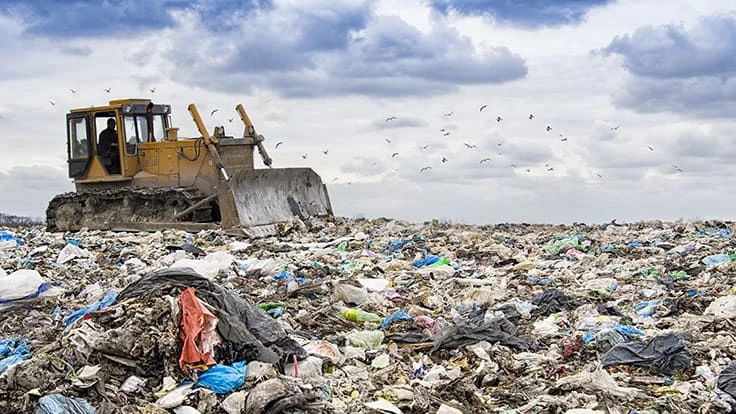
The Minnesota Pollution Control Agency (MPCA) announced on March 18 it has found per- and polyfluoroalkyl substances (PFAS) contamination in groundwater at 59 closed landfills in 41 counties in the state. Groundwater at each of these sites exceeded the Minnesota Department of Health’s (MDH’s) health-based guidance values for PFAS. Overall, the MPCA has found PFAS contamination in groundwater at 98 of the 101 tested sites in the closed landfill program.
Fifteen closed landfills tested have PFAS contamination that exceeds state health-based guidance values by at least 10 times. The MDH has developed health-based guidance values to represent levels for various PFAS in drinking water that it considers safe for people, including sensitive populations, over their entire lifetime.
“The MPCA has found PFAS contamination in almost every closed landfill it oversees,” MPCA Commissioner Laura Bishop says. “Once again, our assessments tell us that PFAS is everywhere in our environment. That’s why the agency needs the ability to use dedicated funds more flexibly to rapidly respond to these urgent contamination incidents.”
In order to rapidly address unexpected environmental releases or incidents, the MPCA requested the ability to use funds in the Closed Landfill Investment Fund (CLIF) during the 2021 Minnesota legislative session. Under current state law, the MPCA must wait until the legislature appropriates funding before responding to a contamination incident. Legislative delays or gridlock could put Minnesota communities at risk.
| Closed landfills with PFAS contamination in groundwater exceeding state health guidelines by more than 10 times | |||
| Landfill | County | PFAS | Times (X) over health-based values |
| Gofer | Martin | PFOA | 1,343 |
| Freeway | Dakota | PFOA | 714 |
| Washington County | Washington | PFOA | 657 |
| WDE | Anoka | PFOA | 197 |
| Chisago Isanti County | Isanti | PFOS | 49 |
| St. Augusta | Stearns | PFOA | 29 |
| Louisville | Scott | PFOS | 22 |
| Faribault County | Faribault | PFOS | 21 |
| Watonwan County | Watonwan | PFOA | 19 |
| Minnesota Sanitation Services | Le Sueur | PFOS | 19 |
| Korf | Pine | PFOA | 18 |
| Crosby American Properties | Dakota | PFOS | 15 |
| East Bethel | Anoka | PFOA | 14 |
| Tellijohn | Le Sueur | PFOS | 13 |
| WLSSD | St. Louis | PFOS | 12 |
At the Gofer Landfill, located in Martin County, multiple PFAS have been detected in groundwater at concentrations 1,343 times the health risk limit at the landfill. PFAS contamination has been detected in nearly all of the monitoring wells at the landfill, in an adjacent creek and one off-site temporary monitoring well. According to the MPCA, all drinking water wells within a mile of the landfill have been tested and PFAS was not detected in any of the drinking water wells. The agency is further investigating to identify the area of contamination coming from the landfill. Gofer Landfill closed in 1986.
Along the banks of the Minnesota River in Scott County, the Louisville Sanitary Landfill operated for 22 years until it closed in May 1990. According to MPCA reports, seven out of 12 active groundwater monitoring wells report PFAS exceedances. The MPCA will sample nearby residential water supply wells as well as Gifford Lake and the Minnesota River.
In addition to PFAS contamination, an underground fire started at the landfill in late 2020.
With the discovery of PFAS contamination in groundwater, the MPCA will expand its water monitoring statewide to ensure drinking water is monitored and the full extent and magnitude of the contamination is known, it says. Ongoing samplings of groundwater around these sites will help determine the impact of PFAS contamination while informing the need for additional remedial actions. Significant PFAS contamination in groundwater can be addressed by installing an engineered system to pump groundwater that will control the movement and reduce the impact of the contamination. The MPCA plans to conduct feasibility studies to determine how best to treat groundwater and leachate contaminated with PFAS.
In February 2021, the MPCA, along with other state agencies, released Minnesota’s PFAS Blueprint—a strategic approach to protect families and communities from PFAS. The blueprint included immediate, short- and long-term strategies that state agencies, the Minnesota legislature, industries and local governments can consider to prevent, manage and clean up PFAS contamination. An identified immediate need was responding when PFAS are found in closed Minnesota landfills, and a short-term strategy centered around developing plans to monitor PFAS in groundwater at active landfills.
Latest from Waste Today
- Vogelsang introduces CC-Mix for biomass handling
- Minnesota selects Circular Action Alliance as PRO
- Waga Energy reports strong revenue growth in 2024
- Landfill Insights: Managing landfill airspace
- New York county expands paint recycling program
- American Biogas Council reports record investment in biogas systems
- Washington installs 30 food waste smart bins to support composting
- Waste Connections reports Q4 results, closes 24 acquisitions in 2024





